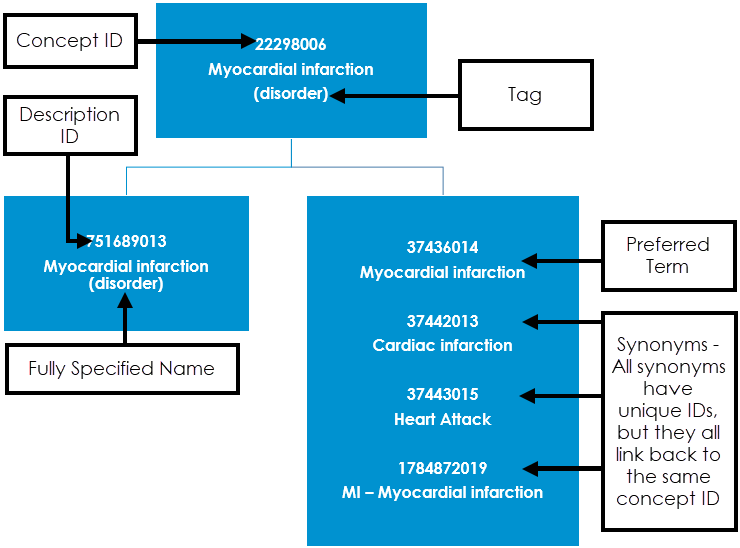What is SNOMED CT?
SNOMED CT stands for Systematised Nomenclature of Medicine - Clinical Terms and is a common, standardised clinical coding language.
SNOMED CT is the most comprehensive and precise clinical health terminology product in the world, it includes:
- Diagnosis and procedures
- Symptoms
- Family history
- Allergies
- Assessment tools
- Observations
- Devices
- Other content to support healthcare delivery
Vision+ uses SNOMED Clinical Terms to record data, this results in:
- Consistent recording and retrieval of information.
- Advanced data analysis.
- Real-time decision support.
- Meaningful sharing of information.
SNOMED Clinical Terms are built of three building blocks:
- Concepts - These are unique codes.
- Relationships - These are the links between to other concepts.
- Descriptions - These are the fully specified names and the synonyms, it is these you select from for recording purposes.
For example:

- The Tag displays after the Fully specified name (FSN) in brackets, this provides an indication of where in the SNOMED CTT dictionary the Concept sits.
- A Preferred Term is designated to the description that most healthcare professionals use for a specific disorder, but you can select any synonym you require.
Within SNOMED CT, Concepts are associated with other concepts using two different types of relationships:
- The is-a relationship which enables concepts to be part of a structured hierarchy that group “like” concepts together. Each concept has a relationship to at least one “parent” concept and as you go down the hierarchy concepts become more detailed and specific.
- An attribute relationship can be used to further define each concept.
A Concept has is-a relationships, identifying what kind of concept it is, for example Clinical finding or procedure, and an attribute relationship which defines the particular concept, for example, for a procedure, it would include finding site, causative agent, laterality, method and many more.
SNOMED CT Hierarchy - SNOMED CT terms are organised into 19 categories each of which covers different aspects of healthcare. From the Code search browser screen in Template Designer you can select Hierarchy to look at terms within the chapter. When selecting a term, it is important to understand the categories. For example, Urine protein test belongs to the following hierarchies:
- Urine protein test - Observable Entity
- Urine protein test (the procedure) - Procedure
Tips for searching for SNOMED CT terms:
- Principally, terms are represented in the singular rather than the plural. Always search for the singular version of a description.
- Full and partial keywords enable you to search for SNOMED CT terms. For example, herpes zoster or by selecting partial match type herp zost.
- There should be no spaces either before or after terms that contain a hyphen, for example, intra-articular.